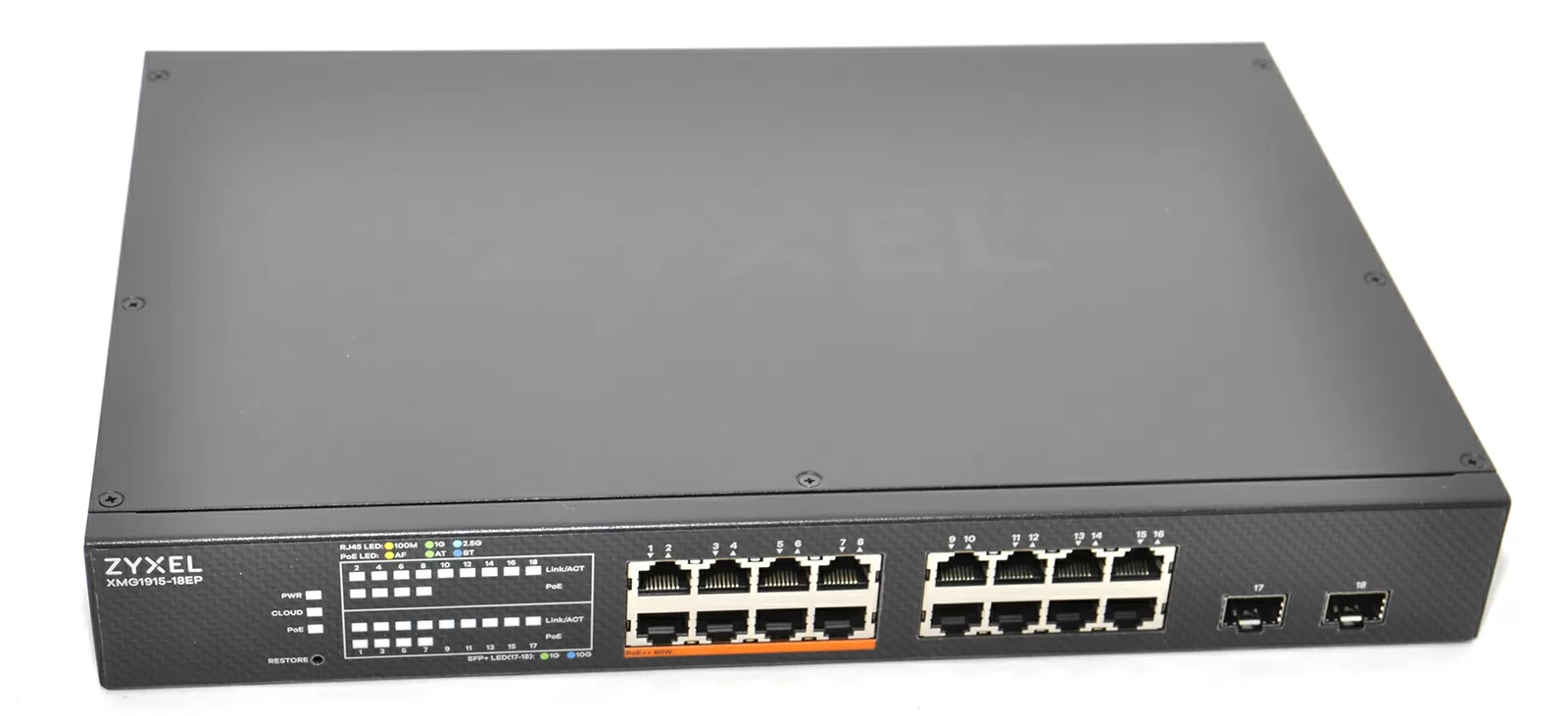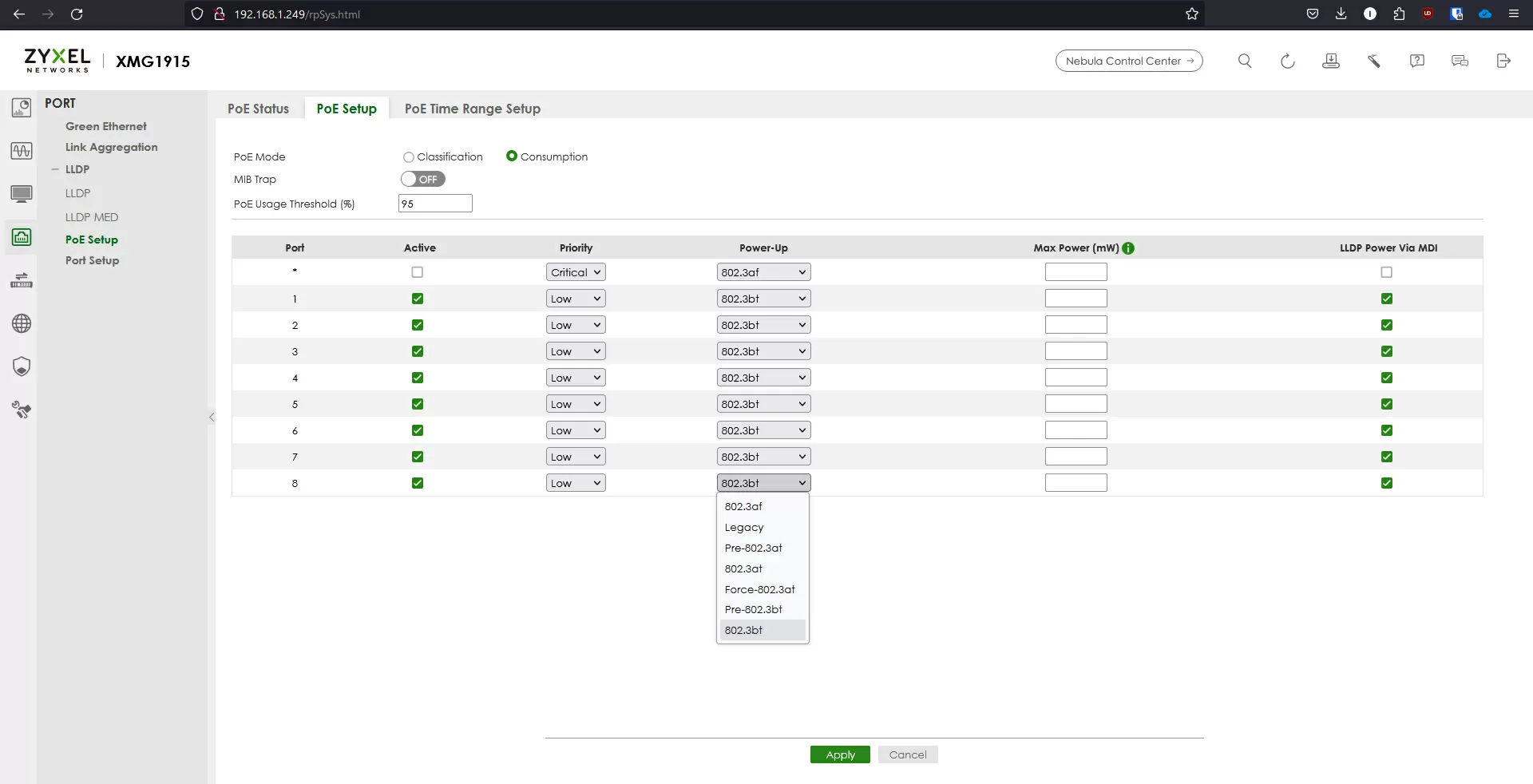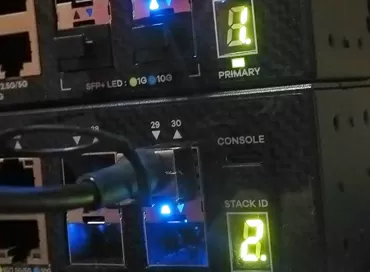Exploring the features of the Zyxel XMG1915-18EP, a 2.5-Gigabit PoE switch with a basic L3
We have a rather interesting class of L3 switches in front of us: multi-gigabit PoE models with a relatively small number of ports, an average PoE budget by modern standards, but 10-gigabit uplinks. They are interesting because the manufacturer has placed 2.5G PoE + 10G in a compact 9-inch rack housing with a silent fan, and such a switch can be installed at home, in a 1-room office, under a false ceiling or in narrow telecommunication cabinets.
For those who already lack 1G speed, and 10G is expensive, this is quite an affordable solution, with full–fledged L2 and basic L3 functionality, which no one ever uses in such scenarios.
Distinctive features
The main purpose of this series is to replace a slow 1G network with a faster 2.5G, and although this is nothing new, previously in such a compact class there were either expensive 10–gigabit models or hybrids in which some ports are 1G and some are 2.5G. This prevented the network from being properly planned "for growth", because now both office NAS's, desktop PCs and often laptops have 2.5 Gigabit ports, and if the network topology involves using L3 on a switch, then the novelty, as they say, completely hits the bull's-eye.
Well, why not? There is support for channel aggregation, SNMP, DHCP Relay, static routing and SNMP plus Syslog for integration into monitoring systems such as Zabbix, Prometheus, etc.
PoE and cooling features
The Zyxel XMG1915-18EP has a PoE budget of 180 Watts, the lower 10-port model is limited to 130 watts, although both variants have the same number of PoE ports: 8 pieces. Each port supports the 802.11bt PoE++ standard with a power of up to 60 watts, which is enough for the most powerful outdoor access points with a heating function. The switch has a compact bodyless power supply, good Rubycon capacitors are used in its design, the protections and filters are completely soldered. Usually, in more expensive models, additional protection is installed on the input outlet itself, but here the manufacturer decided to save money, and in principle, this is not critical.
At the same time, the switch's own consumption remains within reasonable limits - 4.67, 7.75 and 14.48 Watts for the XMG1915-10E (without PoE), -10EP and -18EP models, respectively. With such high efficiency, active cooling may not be required, so in 10-port models there is no fan at all, and in 18-port models it has automatic adjustment, and mostly works so quietly that the switch can easily be installed in an open rack in a room where people work, but for a living room or for installation on the table is a bit noisy.
In the switch settings, you can set the power priority, maximum power, and supported PoE standard for each of the ports. There is also the possibility of supplying power according to a schedule, for example, to turn off some access points after hours. The implementation of this function has one feature: yes, you can assign multiple time ranges to the same port, but they should not overlap.
Features of the component base
The Zyxel XMG1915 is, of course, an office switchboard, not designed for outdoor facilities, no matter what anyone says. It has lightning protection, but it is weak: from static - 8KV / 4KV on the Ethernet ports, from voltage surges - 2 KV on the ports and 2KV / 1KV on the power outlet. The reason for simplified protection against insulation breakdown and high voltage is very trivial: if in expensive switches Zyxel solders individual protection elements on the board, then in the medium-budget segment it relies entirely on the passport capabilities of the components used – the power supply and the interfaces of the physical environment.
On the main board of the switch, the elements are mounted on both sides, and there are only two solid-state capacitors manufactured by Sanyo. A 40 mm Y.S. Tech FD124020EB-N fan with a 3-pin Molex connector is responsible for cooling.
The element base of the XMG1915-18EP looks, although not perfect, but of high quality and generally corresponds to the class of the device, and the manufacturer claims an average time to failure (MTBF) of about 74 years (646958 hours). The warranty is limited, lifetime, that is, until the device reaches EOS status (end of Support - usually 5 years after decommissioning), the user is entitled to free repair and replacement.
Management features
The Zyxel XMG1915-18EP switch can be controlled from the built-in Web interface or through the Nebula Control Center cloud system. There is no need to be afraid that government agencies will abruptly block access to Nebula – this issue is discussed in detail in our article "Will Zyxel Nebula work if the Iron Curtain is lowered".
All modern Zyxel switches are brought to a single Web interface style, and on the home page you can see the status of the ports, click on the desired one, turn off/on or overload the power client. There is no separate interface for managing webcams (Networked AV) in this model, but even from the dashboard main page you can view the status of any of the ports and make a Power Cycle or disable/enable it. There is a search in the web interface, so you can now find the desired function in 1 click. I would like it to take into account user parameters, such as VLAN and port names, but this is only in the future.
As befits a business model, XMG1915 has 2 operating system images that can be updated and downloaded independently of each other, so if you are not satisfied with the new firmware, you can download the previous one, and if the firmware is damaged, the switch will download the backup itself.
What is missing is ACL support and the ability to automatically restart by powering a hung camera or access point based on pings or LLDP response. These features are present in the older XMG1930 series switches (see our review).
From the point of view of L3, in Zyxel XMG1915, of course, everything is boring: IP addresses are linked only to VLANs and only static routing is supported, without conditions. In principle, this is more than enough to separate traffic between WLAN and NVR applications, but no more than that – there is not even its own DHCP server here, and the switch can only act as an intermediate node between the client and the central DHCP server.
To automate management and monitoring, the switch supports SNMP, SSH, Telnet, plus FTP for downloading firmware and configs. Well, standard functions for this class such as RSTP/STP, QoS and Multicast support are present here.
Conclusions
I would like to say that the Zyxel XMG1915 switches are devoid of any zest, but it depends on how you look at it. If you compare with older models from Zyxel (for example, XMG19130), then yes - the novelty looks ordinary and boring, but if you look at other solutions on the market, then there is convenient management via Nebula Control Center, a fairly high-quality component base, constant release of updates and a convenient web interface with a search function. For inexpensive construction of Wi-Fi 6 networks, especially in offices with NAS and local video surveillance, small hotels and warehouses, the XMG1915 has plenty of possibilities.
Michael Degtyarev (aka LIKE OFF)
07/02.2024




























































